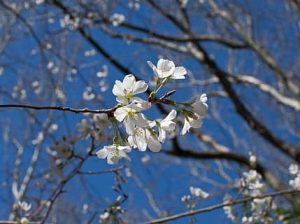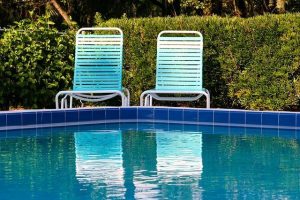If you’re considering planting a hedge, you probably already know that a hedge — a dense row of shrubs or low trees — can be a classy yet economical alternative to a fence, providing privacy, screening, and a host of other great benefits.
A hedge enhances a garden’s appearance and brings many other lifestyle and environmental benefits as well.
This blog will discuss which hedging plants work best here in Perth, and highlight other key considerations in hedging projects.
Not only that, but for comprehensive advice on garden design and plant selection, you can always reach out to our experienced team at Perth Landscaping Experts!
We’d love to help you make a great garden design decision, so your future garden is beautiful, manageable, liveable and sustainable.
If that’s what you want, read on to decide whether hedging is for you!

Reasons to Grow Hedging
Homeowners plant hedges for various reasons — we’ll cover some of the main ones, to help you clarify what you want to achieve, and what to grow.
For Aesthetic Appeal
A hedge can transform your garden, adding structure, visual contrast and a stylish look.
Whether your garden style is formal, contemporary, native or “cottage”, a well-designed hedge with complementary plantings can lift it out of the ordinary.
To Add Value
Property buyers pay more for established, landscaped gardens and experts estimate that hedging adds around 4% to the sale price.
To Disguise Flaws
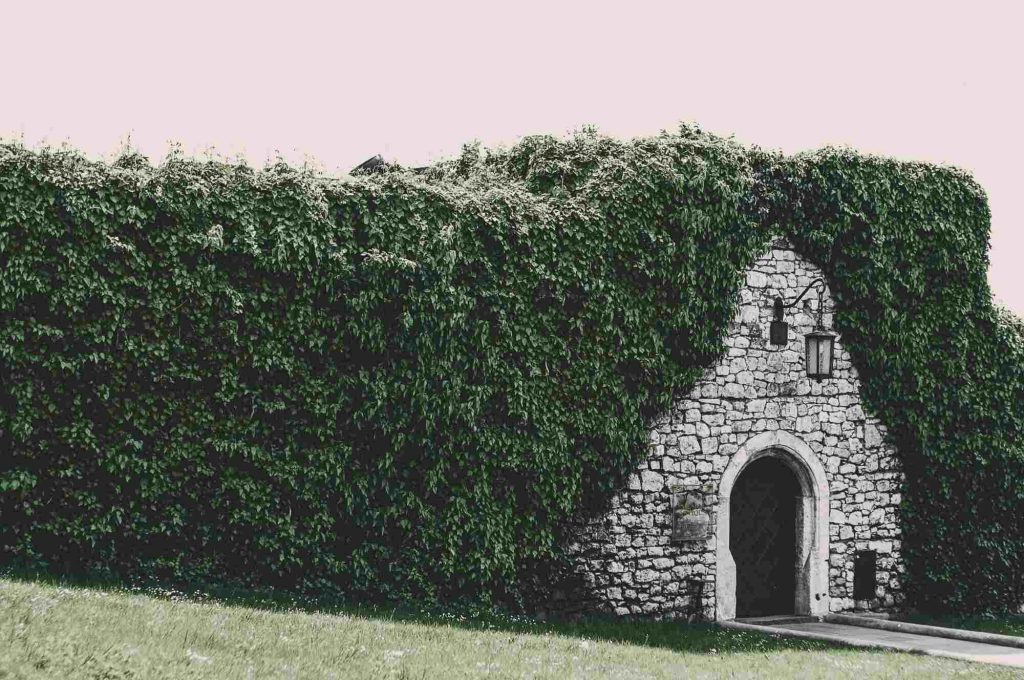
As well as being integral to many stunning garden designs, a hedge can also hide flaws. It can be less expensive than replacing an unsightly wall or fence.
Hedging can screen visually unappealing objects like sheds, clotheslines, solenoid boxes, and air-conditioners (remember, maintain access where needed and always consider the root systems and mature growth of whatever you plant).
For Security
Hedging creates a dense barrier, far more difficult for intruders to breach than a normal fence.
A hedge makes your home safer, without it looking like a fortress!
For Privacy
A hedge can provide privacy for your front garden, or around areas where privacy is particularly important, like your pool.
Councils place height restrictions on fences. Anything above 1.2 metres must be ‘visually permeable’. This makes privacy hard to achieve.
A hedge need not be ‘visually permeable’ and is often permitted to exceed the usual fence height.
Clarify what is permitted with your local council.
To Minimise Noise and Pollution
All plants provide environmental benefits, and improve quality of life, cooling, hydrating and purifying the air.
Researchers have found another benefit of hedges — noise reduction.
On busy roads a hedge can be particularly useful, absorbing noise and air pollution.
As A Windbreak
Hedges were traditionally grown in cold climates for protection from icy winds.
In Perth’s climate, a hedge can also shelter your home and garden from hot, dusty, salty winds. It can help to create a microclimate where delicate plants thrive.
To Keep Animals In or Out
A strategically planted hedge can help keep pets and children from wandering. It can also keep unwanted animals out — the neighbour’s dog won’t be digging up your precious garden!
To Attract Wildlife
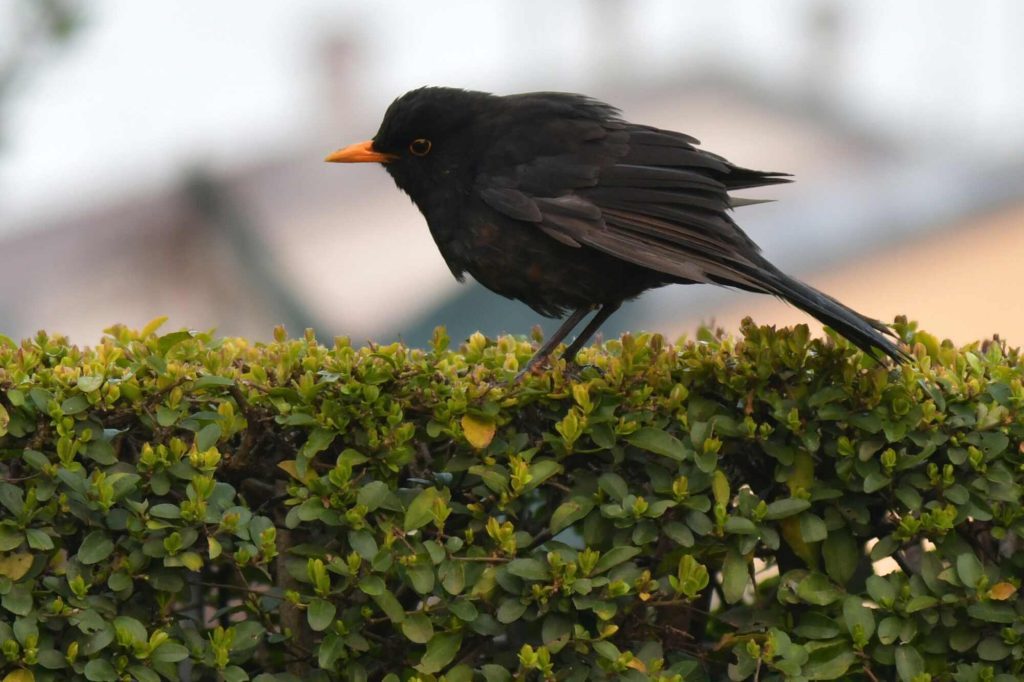
Birds and other wildlife like tree frogs inhabit hedges, feeding on insects before they become garden pests. Flowering hedges attract bees and butterflies, making your garden more environmentally friendly.
Choosing the Right Hedging Plants
So, you’ve decided hedging is for you. What next?
We recommend you design your hedge to complement your existing home and garden. Or for new builds, create a ‘whole garden’ concept before planning your hedge.
Whether you’re hoping to achieve security, privacy, shelter, aesthetics, or just want to hear more birdsong, hedging and companion plants that complement one another will give a more harmonious outcome!
Planning and execution are both crucial to achieving your ideal look and result.
The process is not always straightforward though, so we recommend you seek help when deciding on the right heading plants. This will ensure you choose plants that look beautiful and suit our climate and soil! You may even want to seek expert advice on soil preparation before you begin.
Best Hedging Plants in Perth
In this post, our focus is on helping you become familiar with hedging plants that thrive in Perth.
Issues to consider when selecting plants will include:
- your purpose in planting the hedge
- your garden’s size, layout, and style
- your budget.
Also consider whether you want hedging plants that:
- attract birds and bees (choose fragrant flowers for this)
- create less leaf and petal litter (this helps keep your pool clean!)
- are drought resistant and need less hand-watering
- have non-invasive roots for safety near pipes or paving
- fit your height/width constraints so power lines and pedestrians aren’t impeded
- grow quickly — this means more maintenance.
When investing in extensive hedge plantings, you want a lasting result. That’s why we recommend you work with professionals. They can evaluate soil and conditions (for example sun, water and space), recommending plants that will thrive in your garden! Book a consultation for expert landscaping design advice.
Meanwhile, here are some hedging plants to check out — this will give you an idea of what you like before talking to a designer.
Medium to Tall Hedges
These hedges all grow over 1m tall.
Agonis Flexuosa
An attractive drought-tolerant WA native with white flowers, used in many types of gardens.
Dwarf varieties grow to 1.2m tall. Taller varieties are available.
Bamboo
Dense and fast-growing, with many sub-varieties, bamboo suits a modern garden, but can be intrusive.
Only plant non-invasive varieties and check how tall and wide the variety will become.
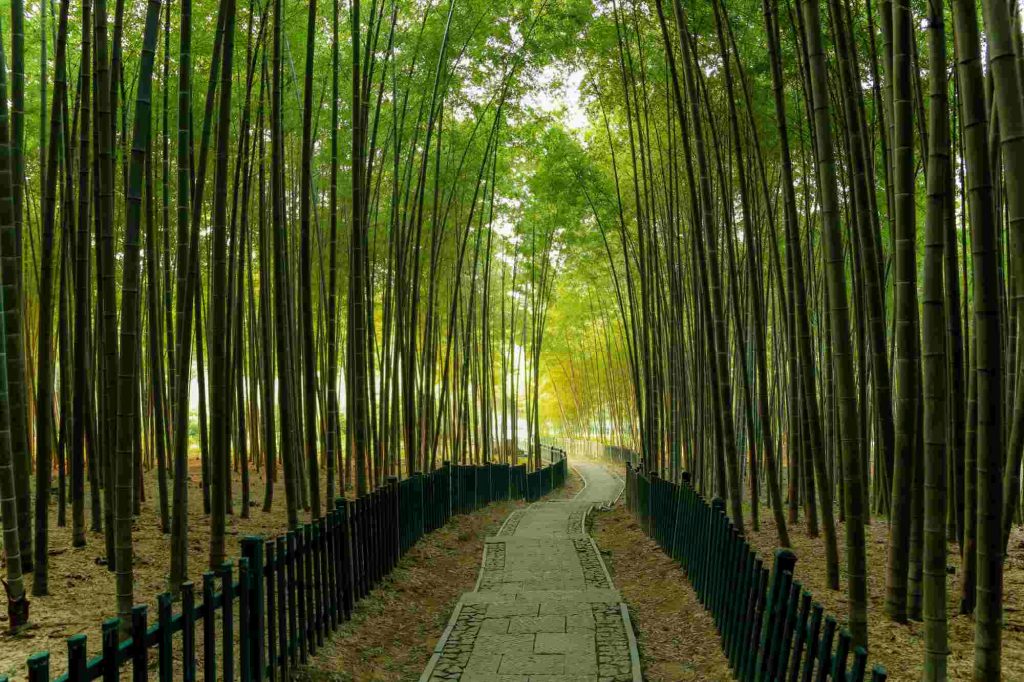
Bottlebrush (Callistemon)
A tough, fast-growing native plant, bottlebrush tolerates most soils and maintains a good shape without much pruning. It attracts birds and bees. Choose a variety that suits your height requirements.
Hibiscus
A popular choice for its colourful flowers and informal, contemporary look, hibiscus is attractive yet tough, fast-growing, and salt-resistant.
Orange Jessamine (Murraya Paniculata)
Orange Jessamine has bright green foliage, growing up to 3m.
Its orange-scented white flowers attract wildlife in spring and autumn.
It suits privacy screening or hedging.
Photinia
Fast-growing, with striking red foliage and white flowers, Photinia suits formal and informal settings and is salt and drought resistant..
Red Robin is a popular variety, growing up to 3m tall.
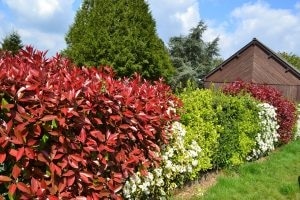
Lilly Pilly (Syzygium)
Lilly Pilly (Syzygium) is a salt and drought-tolerant native, ideal for hedging, screening and topiary. It has glossy, dark green foliage, colourful new growth, flowers and edible berries.
Bush Christmas is a popular variety, growing up to 3m tall.
Viburnum
A traditional favourite — hardy, quick to establish, with attractive flowers and berries.
Fragrant Sweet Viburnum is a popular variety that grows up to 6m tall.
Grevillea
A hardy native, with flower colours ranging from crimson to golden yellow, Grevillea attracts birds and butterflies and makes a great hedge, screen or windbreak.
Robyn Gordon is a popular cultivar, flowering year-round. Some other varieties are close to extinction.
Buxus
Box hedges are a classic option for everything from screening hedges to topiary. They need more water than natives.
Taller varieties can grow 2m high. Slow growth makes them low-maintenance.
African Box is popular in Perth.
Low to Medium Hedges
These are smaller plants, suited to borders and hedges up to 1m tall.
Nandina (dwarf)
Small, manageable shrub, with varied colourful foliage. Stays in good shape without much pruning.
Murraya (dwarf)
Dwarf Orange Jessamine is easily kept to 1m. It has beautiful flowers and fragrance.
Gardenia
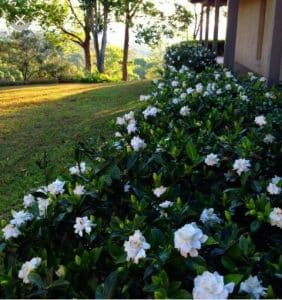
Dwarf Gardenia varieties like Florida make a beautiful perfumed display and stay under 1m.
Gardenias like morning sun, good soil, and plenty of water.
Chinese Star Jasmine
Popular climber with fragrant white flowers that can be clipped into a hedge.
Syzygium
Also known as Lilly Pilly — some varieties grow to 8m, but a few remain under 1m. The most popular is Tiny Trev.
Westringia
A hardy native resembling rosemary, with delicate white or mauve flowers. Some varieties are under 1m.
Other Considerations Before Choosing Hedging Plants in Perth
Before making any final decisions on your hedging plants, consider your unique circumstances and seek expert advice.
For example, the topography of your block means you might be considering a hedge to retain subsiding soil, or you may have particular soil issues which limit planting options.
Before you commit, why not talk to our experienced team at Perth Landscaping Experts to make sure you’ve thought of everything?
How Many Hedging Plants Are Needed?
How many plants you need will depend on why you want the hedge, and what plant you choose.
For example, a hedge planted for security should be dense, so more plants are planted closer together, than for a purely decorative hedge.
A general rule of thumb is 3 plants per metre if the hedge is to be around 1m high.
But here are some examples that show how much variation there can be:
- English Box: up to five plants per metre
- Orange Jessamine: two to three plants per metre
- Viburnum: for tall varieties above 2m, less than one plant per metre
These rules are not hard and fast — if you’re on a budget, you can get away with fewer plants, just by being patient.
Variegated or Regular?
Variegated plants are attractive, but some revert to plain green over time. This is disappointing when they cost more than the plain version — especially if some plants revert and others don’t!
Hedge Repair
Buying a classic plant variety that’s been around a long time will make it easier to replace any plants that don’t flourish — newer varieties can be hard to source.
Hedge Maintenance
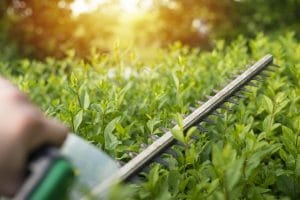
It pays to consider hedge maintenance before you plant — some hedges need a lot more TLC than others!
Planting Your New Hedging Plants in Perth
Now you know which hedging plants do best here in Perth, you’ll be keen to make a decision and start planting! But how can you set your hedge up for success?
Start by digging a hole or trench as deep as the plant’s pot. Remove any rocks, adding compost and fertiliser.
Loosen surrounding soil. Tease out roots and gently plant. Water well, adding mulch on top.
It all sounds simple, but if you feel overwhelmed by plant choices, undecided about your garden style, or daunted by the size of the task, why not get some help?
The friendly professionals at Perth Landscaping Experts can help with your entire project – from advising on the ideal plants, to sourcing and installing them!
Call us today on (08) 6263 4646, email us at [email protected] or contact us via the website to find out more!
]]>Here is our guide on all you need to know when it comes to landscaping – even if you are a total beginner.
What is Landscaping?
So let’s get straight to the point and start answering the question “what is landscaping?”
Landscaping refers to the process of modifying the visible features of an area of land, including altering the terrain, planting trees and shrubs, installing structures such as patios and walkways, and creating outdoor living spaces. It can also involve designing and maintaining gardens and other areas of plants, as well as managing the overall appearance and functionality of the outdoor space. Landscaping is a popular way to improve the appearance and value of a property, and it can also provide practical benefits such as providing shade, creating privacy, and controlling erosion.
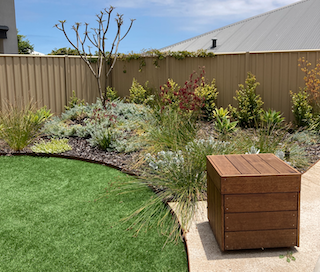
There are many different approaches to landscaping, and the style and design of a landscape will depend on the goals and preferences of the homeowner, as well as the local climate and available resources. Some people may choose to hire a professional landscaper to design and install their landscape, while others may prefer to do the work themselves.
No matter what approach is taken, there are several important considerations to keep in mind when landscaping.
Let’s go more in-depth in this blog to find out more about what landscaping is and its benefits…
Benefits of Landscaping
There are many benefits to landscaping a property, both practical and aesthetic. A well-designed landscape can improve the overall appearance and value of a property, and it can also provide practical benefits such as providing shade, creating privacy, and controlling erosion. Landscaping can also provide an opportunity for outdoor recreation and enjoyment, and it can contribute to the overall health and well-being of the homeowner. Whether you’re a beginner or an experienced landscaper, there are always new things to learn and discover in the world of landscaping.
Some of the many benefits to landscaping a property include:
Improved Appearance
A well-designed and maintained landscape can significantly improve the appearance of a property, making it more attractive and appealing to potential buyers or renters.
Improved Lifestyle
A well-designed landscape can add huge value to the lives of the people who live there! From encouraging the kids to play outside through the use of play spaces and lawn areas, to entertaining areas or relaxed spaces which make spending time at home more enjoyable and fulfilling, your landscape should make your property and outdoors more attractive, livable and lifestyle friendly.
Increased Property Value
Landscaping can also increase the value of a property. A beautiful landscape can make a property more valuable, and it can also increase the resale value of a home.
Practical Benefits
Landscaping can provide practical benefits as well, such as providing shade, creating privacy, and controlling erosion. A landscape may also include outdoor living spaces such as patios and walkways, which can be used for recreation and relaxation.
Improved Health and Well-Being
Landscaping can also have positive effects on the health and well-being of the homeowner. Being surrounded by nature and having access to outdoor spaces can improve mental health and reduce stress, and it can also encourage physical activity.
Environmental Benefits
Landscaping can also have environmental benefits. Planting trees and other vegetation can help to improve air quality and reduce carbon dioxide levels, and it can also provide habitat for wildlife.
Energy Savings
Landscaping can also help to save energy and reduce energy costs. For example, strategically placed trees and shrubs, natural lawn and other green areas can provide shade and an overall cooling effect for your property, which can help to reduce the need for air conditioning in the summer.
Two Key Landscaping Terms
There are two types of landscaping – hardscaping and softscaping.
Hardscaping
When you hear the term ‘hardscaping’ this simply refers to any ‘hard’ landscaping elements such as decking, concrete, paving etc.
Softscaping
You may have guessed based on the above, but ‘softscaping’ refers to the green elements in a landscape; trees, shrubs, flowers and lawn, etc.

Types of Landscaping Services
While it’s possible to do your own landscaping if you have the time, resources and skills, you’ll get much better results, quicker and of a higher, enduring quality if you enlist the help of an expert Landscaping company like us at Perth Landscaping Experts with our professional team of landscapers.
Landscape Design
No landscaping project should begin without a careful, thorough design and planning process. This makes sure that the end result is a space to enjoy, admire and inspire – ensuring that the landscape is well-suited to the local climate and the needs and goals of the homeowner.
A professional local landscape designer has the training and experience to create a landscape that is both visually appealing and functional. They can provide valuable insights and recommendations based on their knowledge of plant materials, design principles, and local conditions.
A key element that often goes wrong in a DIY landscape is the plant choice. A designer with expert plant knowledge will select plants and other elements that are well-suited to the local climate and soil conditions, which can help to reduce maintenance costs and improve the overall health of the landscape.
Landscape Construction
It’s not enough to design the perfect landscape, you need to be able to construct it with quality results. Using poor quality materials, incorrect site preparation, or cutting corners during landscape construction will leave you with many headaches and problems in the long-run, so it’s best to bring in a professional landscape construction company for this part.
An expert Landscaping company should be able to offer all areas of landscape construction services, including:
Lawns
Lawns are an area of grass that is maintained and kept short. They are often used for recreational purposes such as playing sports or lounging, and they can also provide a nice green backdrop for a landscape. There are many different types of grass that can be used for lawns, and the right lawn choice will depend on the local climate and the desired appearance and maintenance requirements.
Trees
Trees are large, woody plants that are often used in landscaping for their aesthetic value and practical benefits. Choose your landscape trees carefully to make sure that their size, type and root systems are right for each location in your landscaping. Trees can provide shade, create privacy, and improve air quality. They can also provide habitat for wildlife and contribute to the overall health of the environment. Trees can be either deciduous or evergreen, and they can be flowering or non-flowering.
Shrubs
Shrubs are often used in landscaping as hedging or screening plants for their compact size and versatility. Shrubs can be used as border plants, as screens, or as standalone specimens, and they can be found in a variety of shapes, sizes, and colours. Like trees, shrubs can provide shade, create privacy, and improve air quality, and they can also provide habitat for wildlife.
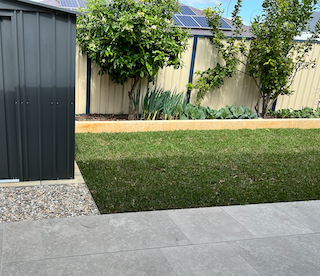
Garden beds
Garden beds are any areas of a landscape that are dedicated to growing plants. These beds can be used to grow a variety of plants, including flowers, vegetables, and herbs. Planting beds can be designed in a variety of shapes and sizes, and they can be raised or ground level.
Water features
Water features are decorative elements in a landscape that incorporate water, such as fountains, ponds, or waterfalls or fountains. Water features can add visual interest to a landscape, and they can also provide a soothing sound and a cool, refreshing environment.
Pathways
Pathways in a landscape that are used for separating areas and providing clear access throughout the landscape. They can be made of a variety of materials, such as concrete, brick, or stone, and they can be straight or winding. Pathways can be used to connect different areas of a landscape, or they can be used as a decorative element. They can also have spaces between them to allow greenery to grow, creating a softer look.
Driveways
Driveways are paved areas that are used for parking or driving vehicles. They can be made of a variety of materials, such as asphalt, concrete, or pavers, and they can be straight or winding. Driveways can be used to provide access to a property or to create an attractive entrance to a home.
Walls
Walls can be used in landscaping for a variety of purposes, such as creating boundaries, providing privacy, or adding visual interest. Walls can be made of a variety of materials, such as stone, brick, or concrete, and they can be found in a variety of styles and sizes. They can also have features such as climbing plants or screens added to soften their look and make them a great backdrop in a landscape.
Fences
Fences can be used in landscaping to create boundaries, provide privacy, or add visual interest. Fences can be made of a variety of materials, such as wood, vinyl, or metal, and they can be found in a variety of styles and sizes. These can also have elements such as screens, climbing frames affixed to them to improve the overall appearance.
Garden Sheds
Garden sheds can be used for storage or as a workspace. They can be made of a variety of materials, such as wood, metal, or plastic, and they can be found in a variety of styles and sizes. Work with your landscape designer to add screening or planting to make them a part of the landscape or hide them so they don’t negatively impact the overall look of the design – but you still get the advantage of additional storage to keep your garden areas tidy.
Decking
There are a myriad of decking options to suit any landscape, from hardwood to composite, or other materials, and they are used for creating additional outdoor living spaces. Decking can be used to create an outdoor living space, such as a patio or a seating area, and it can be found in a variety of styles and sizes.
Styles of Landscaping
Before starting any landscaping, it’s important to decide on the style you want for your property. There are many different types of landscaping, and the style and design of a landscape will depend on the goals and preferences of the homeowner, as well as the local climate and available resources.
If you’re struggling to come up with ideas or make a decision, below are some styles you might consider.
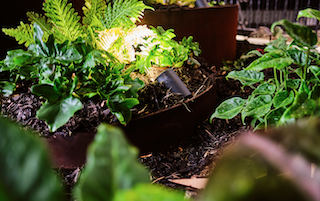
Tropical
Want a lush, tropical landscape to ‘escape’ to? This type of landscaping is characterised by lush, tropical plants and a warm, humid climate. Tropical landscaping design may include elements such as palm trees, exotic flowers, and water features. While trickier to achieve in Perth due to our dry climate and sandy soils, it is still possible with careful planning and soil preparation, along with a great reticulation system and maintenance.
Japanese Garden
The ultimate landscape style for relaxation and a still, zen atmosphere, this type of landscaping is characterised by the use of natural materials such as stone, water, and plants to create a peaceful and serene environment. Japanese garden landscaping may include elements such as waterfalls, koi ponds, and carefully pruned trees and shrubs.
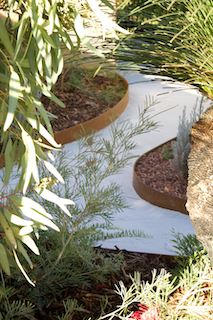
Native
This is our favourite type of landscaping – focusing on using plants that are native to the local area. Perth has a wide range of natives to choose from which are all adapted to the local climate, making it easier to maintain as well as requiring fewer resources to keep healthy. Native landscaping can also help to conserve natural resources and provide habitats for local wildlife. Not to mention – this style of landscape looks amazing!
Desert – or Xeriscape style
This type of landscaping is designed to conserve water, and it is often used in areas with limited water resources – a popular option for us here in Perth. Xeriscape landscaping typically includes drought-resistant plants from the succulent family (such as such as Aizoaceae, Cactaceae, and Crassulaceae), mulch, and efficient irrigation systems. While you might think it would look sparse and boring, these landscapes can look striking while being incredibly easy to maintain!
Formal landscaping
This type of landscaping is characterised by a symmetrical and organised layout, with straight lines and precise shapes. Formal landscaping often includes elements such as formal gardens, topiaries, and carefully manicured lawns. Think Versailles or English mansions – straight from Downton Abbey. This is a very popular modern style but will require a lot of maintenance, so if you aren’t up to it but love the look, make sure you find a great garden maintenance company in Perth to take care of your investment for you.
Informal / Cottage Gardens
Think wildflowers and lush and varied planting. This type of landscaping is more relaxed and natural, with a less formal layout and a focus on native plants and natural materials. Informal landscaping may include elements such as wildflower gardens, natural stone pathways, and meandering streams. These also require expert maintenance to make sure the look stays natural and wild but attractive and true to the design – not overgrown and messy.
These styles are just the tip of the iceberg – the options for landscaping styles are endless. Do plenty of research to find what you like and don’t, then work with a professional landscape designer to customise your look and make the most of your space.
What to Consider Before You Start Landscaping
Along with choosing your landscape design, style and ideal landscaping elements, you need to first think of your goals. Will you be staying in the property forever, or is the landscaping purely to add curb appeal to sell the property? This helps determine the scale of your investment and the complexity of the elements you choose. Also, think about the overall lifestyle requirements. Do you need an entertaining area, pool, play area or relaxation areas? What do you want/need to be able to do outside?
Now that you have a good framework and overall goals, it’s time to think about the details…
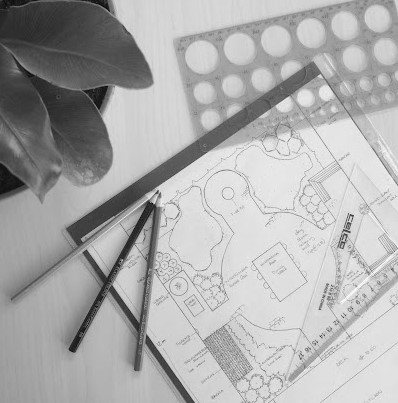
What to Think About When Starting Your Landscaping Project?
- First, it’s important to consider the layout and design of the landscape. This includes determining the overall theme or style of the landscape, as well as deciding on the location of different elements such as plants, trees, and structures. It’s also important to consider the size and scale of the landscape, as well as the surrounding environment and the available sunlight and water resources. Need help with this step? Starting your project with a professional landscape design consultation can get you off to a great start.
- Next, it’s important to choose the right plants and trees for the landscape. This will depend on the local climate and soil conditions, as well as the desired appearance and function of the plants. Some plants may be chosen for their aesthetic value, while others may be chosen for their practical benefits such as providing shade or attracting pollinators. It’s also important to consider the maintenance requirements of different plants, as some may require more care and attention than others.
- In addition to plants, there are many other elements that can be included in a landscape design, such as patios, walkways, and retaining walls. These elements can provide functional benefits such as creating outdoor living spaces or controlling erosion, as well as adding visual interest to the landscape. It’s important to consider the materials and design of these elements, as well as their maintenance requirements and overall cost.
- Once the landscape is designed and installed, it’s important to maintain it to keep it looking its best. This may involve tasks such as watering, pruning, and fertilising plants, as well as controlling pests and weeds. It may also involve regular maintenance of any structures or other elements in the landscape. Whatever you choose to include in your landscape, make sure you think about the maintenance required so that it suits your needs in the long term.
Where to Find Landscaping Ideas
Now that you’ve read our beginners guide explaining what landscaping is, I’m sure you’re eager to get started. So, here are a few tips for where to find good landscaping ideas:
- Observe your friends and families landscaping designs and talk to them about it and the reasons behind what they chose for the style and various features
- Research using magazine, books, television and the internet (you can find some great ideas on Pinterest)
- Get a professional design consultation with a company such as us at Perth Landscaping Experts
- Read landscaping blogs or check out recent design award winners
Ready to Start Your Landscaping Project?
If all of the above has given you some great ideas but also made the idea of your project seem quite overwhelming – don’t hesitate to get in touch with us. We can take you from design to the finished construction and make it easy to build the landscape of your dreams.
Call our friendly team today on (08) 6263 4646 or contact us here to begin.
]]>Maybe you’re gazing sadly at your existing lawn, wishing it was green and springy like it used to be, instead of sparse and brown!
Or maybe you are planning a new build or renovation, and want to get everything right the first time.
Let’s face it, most of us don’t know much about grass — our lawn is something that is just there, doing its job, keeping the backyard from becoming a dustbowl, or making the front yard look presentable.
We often inherit someone else’s choice of lawn, and don’t even necessarily know what type of grass we have!
If you are planning to establish a new lawn, the type of grass you choose will impact your landscape, and even lifestyle, in the future. It will determine how often you need to mow, and the amount of maintenance required; like how much water and fertiliser are needed.
Choosing a grass type that doesn’t suit your conditions may mean your lawn dies in winter or struggles in summer.
Your home’s value can also be enhanced by a beautiful lawn, while a scruffy lawn can detract from ‘street appeal’.
So whether you are building, revamping, or starting over because your old lawn is beyond repair, do your homework before you commit. It might help you avoid a lifetime of being a slave to your lawn!
- Lawn Grass Types in Australia
- What to Consider When Choosing Types of Grass
- What to Consider When Choosing Types of Grass for Your Lawn
- Grass Types in Western Australia
- Buffalo grasses – ‘Palmetto’ and ‘Sir Walter’
- Zoysia grasses – ‘Empire’, ‘Sir Grange” and ‘Platinum’
- Couch Grasses – ‘Bermuda’ and ‘Wintergreen’
- The right grass for you – make the choice with Perth Landscaping Experts
Lawn Grass Types in Australia
There are a variety of lawn grass types available in Australia, but not all of them are suited to Perth’s unique climate and sandy soil.
Grass types in Australia are often those that have succeeded in the US or Asia, suited to either temperate or tropical climate zones.
Western Australia includes several climate zones. Perth homeowners may find success with both warm and cold season grass types.
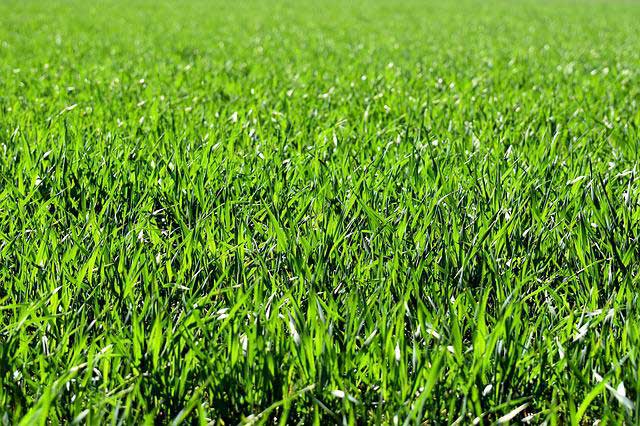
What to Consider When Choosing Types of Grass
Before choosing types of grass to plant or deciding to lay turf, consider what you want from your lawn, and what you are willing to do.
- Do you just need a tough, serviceable lawn that will be low maintenance, and safe for kids to play on?
- Or do you want a truly beautiful lawn to complement an upmarket home – soft underfoot, and brilliant green in colour.
- Is your budget strict? Or will you pay whatever is needed to get the right result?
- What about the time and effort you are willing to put in to establish and maintain a new lawn?
To get the result you want, you need a plan and a realistic idea of what’s involved.
Deciding whether to lay turf or grow a new lawn from seed or runners
The best lawn grass choice can transform your garden, adding value to your property and creating a lush green environment. Grass can even help to cool your garden, and make the garden safer and more enjoyable for you, your children and your pets.
So what is involved in choosing lawn grass?
Well, before you choose your grass type and method of establishing a new lawn, it pays to consider:
- your soil
- the ‘micro climate’
- water availability
- how much sun the area gets
- how much time you can spend establishing and maintaining your lawn
- your budget.
The pros and cons of growing grass from seed (or runners)
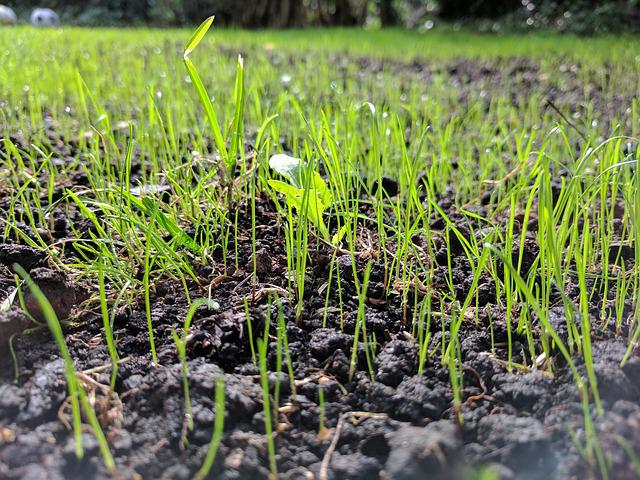
PROS of growing grass from seed:
- affordability
- no great skill, strength or stamina is needed
- wide choice of grass types
- lawn seeds can be a blend of grasses, for a hardier lawn.
Some grasses won’t grow from seed, only from runners.
CONS of growing grass from seed (or runners):
- seeded lawns may need reseeding several times (birds can devour seed, rain can wash it away)
- weeds invade seeded and runner lawns in the early stages
- it will be months before the lawn is usable
- the season for establishing these lawns is limited
- grass can die if conditions aren’t right.
- a lot of watering is needed for the first few months – if you work long hours it may not be practical to grow grass from scratch.
The pros and cons of laying turf
The PROS of turf include that it:
- is the quickest, easiest way to establish a new lawn
- gives a high quality, consistent look
- is usable within weeks
- will always be a grass suited to local conditions.
The CONS of turf include:
- it is expensive, especially for large areas
- there are extra costs (or heavy work) in preparing the site and laying turf
- the choice of grass types is slightly more limited than with seed.
Talk to a landscaper with expertise in lawns (like Perth Landscaping experts!) for advice before deciding on grass types.
What to Consider When Choosing Types of Grass for Your Lawn
Growing conditions
First, consider your soil type. For sandy soil, choose grass that likes to be well-drained.
Think about your ‘microclimate’ – salt air, frost, shallow soil, overshadowing, urban heat and drainage can all be factors.
Another key condition is hours of sunlight. Is your lawn mainly in shade or sun? Certain lawn grasses do well in shaded areas, others die back if there isn’t enough sun.
If an area is too heavily shaded, the lawn may not be viable. You might have to consider paving, ground cover or artificial lawn.
Again it pays to consult an expert landscaper, who can assess the growing conditions and advise on options.
Lifestyle and maintenance time and costs
Be realistic about your lifestyle and how much time you can devote to lawn care, both while establishing your lawn, and later.
Growing grass from runners, or planting a seed lawn requires significant time and effort. You will need to water, fertilise and weed during the establishment period and long term.
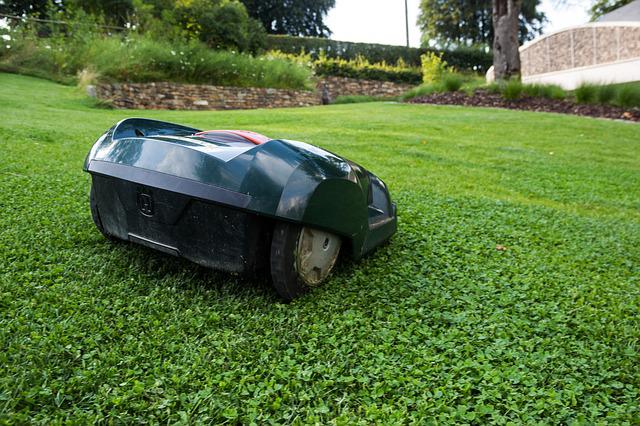
Think about how often you want to mow (or pay for mowing) in the long term. Some grasses require much more frequent mowing than others. For some, it is recommended you use a cylinder mower, another big outlay.
Water/fertiliser requirements and sustainability
Is the cost of water important to you? Do you value sustainability?
Some grass types survive without a problem being watered just twice weekly in summer, and some need little or no fertiliser. Others are much thirstier and hungrier.
Fertiliser and water are ongoing costs, particularly if scheme water is used, and costs will only increase in the future. Bear this in mind when selecting grass.
NOTE: Twice weekly watering is the maximum allowed with scheme water in Perth, using an automated system. Bore owners can water three times a week, but this may soon change to twice weekly.
Watering exemptions are possible when installing new lawns — you can apply via the Water Corporation.
Budget
As already discussed, decisions often end up being budget-driven.
If you can afford it, instant turf gives ‘instant gratification, with minimal up-front effort.
Fast-growing grasses are usually the most economical.
To get the best result you may need to install an automated irrigation system if you don’t already have one. If you travel for work or your schedule allows little time for watering, this is a must.
Talk to a landscaper about which systems work best in Perth conditions, and get some quotes.
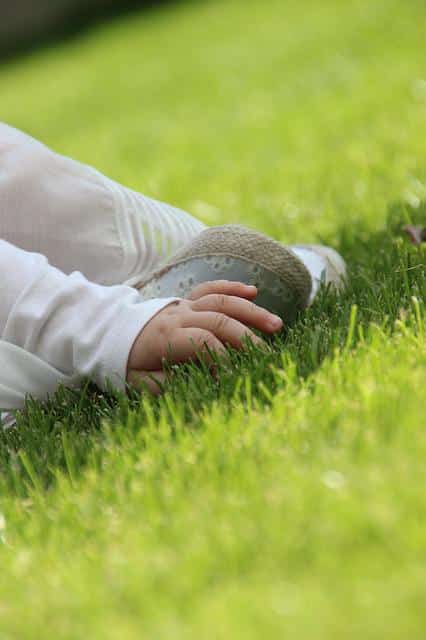
Aesthetics, feel and the ‘sneeze factor’
If the aesthetics of your home are a primary consideration, ask a landscaper to point you to some lawns they have installed. Check them out to see what appeals. Consider the colour and feel of the grass.
If children will be playing on grass (or you like to exercise on the lawn) softer varieties are most appealing.
If anyone has allergies, consider low-seeding grass types.
Area
The larger your proposed lawn area is, the more strategic it pays to be.
For large areas, costs can be substantial. Buying turf, runners or seed, watering costs while establishing grass, and long-term water, fertiliser and mowing costs, all add up.
There are some ‘tricks of the trade’ that may help – ask a landscaper for advice.
Grass Types in Western Australia
A variety of lawn grass types are used in Western Australia.
We have already discussed problems that can arise if you plant grass that doesn’t suit your conditions, so it’s important to choose the right grass for your garden and lifestyle.
Here we share our knowledge of ten of the best types of grass for lawns
We explain which conditions suit each of them, and their pros and cons, to help you make an informed choice.
Buffalo grasses – ‘Palmetto’ and ‘Sir Walter’
1. Palmetto Buffalo (stenotaphrum secundatum)
Palmetto Buffalo is one of the most popular grass types for Perth lawns.
Its benefits include:
- soft texture
- vivid green colour almost year-round
- low thatch (helps to stop it drying out)
- drought tolerance — it survives the full glare of our summer sun
- no rhizomes or underground roots, so it doesn’t invade pavers and garden beds
- hard-wearing, suits high-traffic areas
- produces little seed, so unlikely to trigger allergies
- needs less mowing than most buffalo grasses.
Palmetto’s CONS include that it:
- is not cheap
- loses colour in winter if not in full sun
- is slow to recover if damaged.
RECOMMENDED FOR: gardens where moderate watering and maintenance are desirable, families with children, and locations with good winter sun.
2. Sir Walter Buffalo (stenotaphrum secundatum)
Sir Walter is another very popular soft buffalo grass, very similar to Palmetto.
Key differences include these PROS. Sir Walter:
- keeps its winter colour in partial shade
- grows actively in winter, improving appearance
- has an even greater tolerance for wear and tear than Palmetto
- has slightly better drought tolerance.
CONS of Sir Walter include that it:
- is not as low-thatch as Palmetto
- produces more seed
- is faster growing so
- needs mowing more often.
For more information, check out this independent research carried out in WA.
RECOMMENDED FOR gardens where moderate watering and maintenance are desirable, families with children, locations with less winter sun.
3. Kikuyu (cenchrus clandestinus)
Kikuyu is another popular grass type. Its PROS are being:
- inexpensive
- sun tolerant, drought-resistant
- suits sandy soils
- fast-growing, covers bare areas quickly
- hard to damage, fast to recover from damage
- self-sufficient, no expensive fertilisers needed
- attractive in winter
- resistant to pests and diseases
- not highly allergenic.
Kikuyu does have some CONS. It:
- invades garden beds
- needs 5-6 hours of sun per day
- requires weekly mowing in summer
- is almost impossible to eradicate, resisting most herbicides
- forms a dense thatch – insects and fungus may thrive, depleting soil nutrients.
RECOMMENDED FOR: large gardens, ovals, parks, or any project with a tight budget.
Zoysia grasses – ‘Empire’, ‘Sir Grange” and ‘Platinum’
4. Zoysia Empire (Zoysia Japonica)
Zoysia Empire is a popular warm-weather grass. Its PROS include being:
- attractive
- soft underfoot
- shade tolerant for up to 40% of the day
- extremely drought resistant
- non-invasive and pest resistant
- low maintenance, not needing frequent mowing.
CONS include Zoysia being:
- relatively expensive
- not frost tolerant
- slow to establish, especially if growing conditions are not quite right
- slow to recover after damage.
RECOMMENDED FOR: Small to medium gardens, areas with light shade and families with children.
5. Sir Grange Zoysia (Zoysia Japonica)
PROS of Sir Grange Zoysia are that it:
- needs only 3-4 hours of sunlight
- is low maintenance, less mowing, pesticide and fertiliser than most grass
- is highly drought tolerant
- is fine, and soft
- recovers well if damaged.
CONS of this grass include:
- expense
- it is thick, so heavy work to mow, and can be damaged if cut wrongly
- it’s slow to recover if damaged.
RECOMMENDED FOR: Small to medium gardens, or larger spaces where budget permits and gardens in high-density areas where overshadowing is an issue.
6. Platinum Zoysia (Zoysia Japonica)
Platinum Zoysia’s PROS include that it:
- thrives in extreme heat
- requires less watering than most lawns – it rolls its leaves to conserve water
- is dense, soft to touch and dark green in colour
- is non-invasive of garden beds
- can be mown with a rotary mower (many fine leaf types of grass need mowing with a cylinder mower).
Platinum Zoysia’s CONS include:
- expense
- it performs less well in shade and may go brown in winter
- slow-spreading.
7. Fescue (Schedonorus arundinaceus)
Fescue is another popular grass, best suited to a cool climate but used in Perth.
Its PROS include that it:
- is hardy, grows well in poor soil
- does not need frequent mowing
- doesn’t die back in winter
- has deep roots, survives without irrigation if rainfall is regular
- germinates quickly.
Fescue’s main CONS include that it is:
- susceptible to pests and diseases in wet conditions
- coarse and bristly.
RECOMMENDED FOR: Cool areas with good rainfall and well-drained soil.
Couch Grasses – ‘Bermuda’ and ‘Wintergreen’
8. Bermuda Couch (Elymus repens)
Bermuda Couch is another popular grass variety in Perth. Its PROS include being that it is:
- hardy, with a strong root system
- drought resistant yet survives being waterlogged
- tolerant of sandy, saline, acidic, alkaline, and clay soils
- fast to establish
- traffic tolerant
- quick to recover if damaged.
Some CONS of Bermuda Couch include that it is:
- not shade-tolerant
- invasive, creeping into garden beds
- less soft than some couch grasses.
RECOMMENDED FOR: family lawns with high wear and tear, climates with extreme heat and wet.
9. Wintergreen Couch (Elymus repens)
‘Wintergreen’ Couch, also called Nullarbor Couch, is very popular in Perth. Its PROS include being:
- tough, hard wearing
- tolerant of winter cold and strong sun
- soft, fine, a good colour
- relatively cheap
- environmentally friendly.
CONS of this grass include that it:
- loses colour in winter if not well-maintained
- invades paving, garden beds
- can’t be eradicated using general herbicides
- is expensive to maintain.
RECOMMENDED FOR: Suburban homes with low water use and/or a tight budget, golf courses, tennis courts, and wherever close mowing is required.
`10. Elite Backyard Blend
Elite Backyard Blend is a popular seed mix.
It contains Sports Turf Ryegrass (Lolium perenne) and Creeping Red Fescue (Festuca rubra).
Its PROS include:
- shade tolerance
- drought resistance
- summer-active and winter-active seed types
- soft texture, good colour
- reasonably hard wearing
- resilient in winter
CONS include:
- not coping well with harsh summers
- needing plenty of water in summer to stay green.
RECOMMENDED FOR: Suburban homes with high traffic, shady gardens, and frost-prone areas. It suits regions where conditions can be hot and cold at different times.
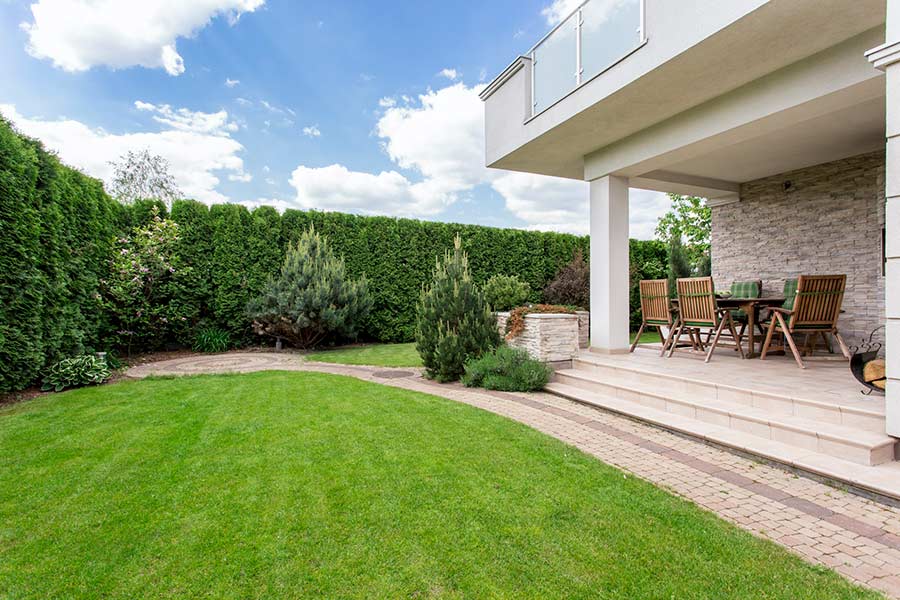
Best ‘All Rounder’ Lawn Grass Type
Are you still struggling to choose the right grass for your lawn?
We’d love to be able to recommend the best all-rounder grass and solve your dilemma, but it just isn’t quite that simple.
There are certainly some very popular grasses, but as we’ve explained, the best results come from analysing your growing conditions, taking into account your budget and the time you can realistically spend on maintenance.
The best thing to do if you’re unsure which types of grass to plant is to contact the experts at Perth Landscaping. We’ll look at your site, listen to your needs, and help choose the best lawn grass for you. We can even help you install it so that you get that perfect finish. Our sister company Perth Gardening Experts also have some top lawn care tips which will help too.
In the long term, getting it right the first time could save you a lot of time, money and frustration!
The right grass for you – make the choice with Perth Landscaping Experts
So how will you choose the right grass to create your own personal oasis of green?
We’d love to help with your choice. Give us a call today on (08) 6263 4646 .
]]>You don’t need a big area to create a lush, colourful tropical garden.
When it comes to creating a tropical garden in Perth, there are a few things you should know first…
How to prepare your garden for tropical planting
A key consideration when planning a tropical garden is that the climate here in Perth is very dry. To create your lush tropical garden, you will need to have a proper irrigation system to enable your tropical plants to thrive. They need much more water than our native plants, and won’t handle drought conditions without help, so adding a carefully designed reticulation system is crucial.
Preparing your soil is the other key element to a successful tropical garden. Here in Perth, we have very sandy soils and sand is not necessarily the best growing medium for most tropical plants. To give them the best chance of first establishing when planted, then thriving for years to come, you will have to carefully improve your soil before planting. This is best to speak to an expert about so they can check the nutrient levels in your soil and apply the right amounts and balance of improvers for the plants you want.
Best tropical garden plants for Perth gardens.
When you know the right tropical garden plants for creating the tropical look in a climate like Perth, your garden will have a better chance of success.
This is why we’ve created a list of low-maintenance tropical garden plants that you can grow in your garden here in Perth.
Blanchet’s Aechmea – ‘Aechmea blanchetiana’
This is quite a large plant and grows a more intense shade of orange depending on the amount of sun it receives.
When it starts flowering, the mother plant begins to die and starts to grow new offsets around the base of the plant. These offsets get their nutrients from the dying plant, and once they grow about a third of the plant, you can replant them in different spaces in your garden.
The leaves have sharp backward-facing spines along their edges, so we recommend using gloves while handling this plant.
When you replant the offsets, take care not to plant them too deep into the soil as this can cause them to die.
Don’t overwater these plants. It prefers dry to damp soil as too much moisture can cause the plant to rot.
Slender Weavers – ‘Bambusa textilis’
Slender Weavers is a type of Clumping Bamboo that has very thick and upright growing canes.
It is ideal for tight spaces and gives you an instant tropical feel while adding privacy because it grows super-fast.
You can plant them on the edge of your garden to get a lush-green privacy screen. It’s the king of screening plants for it can grow up to 6 m in height with full sun or part shade and a splash of water.
Crotons
If you want to focus on adding more color to your garden primarily, crotons are an excellent option.
There are several different species and cultivars, and they are known for their easy maintenance and colorful foliage. They will add a multitude of colors to your garden like orange, red, yellow, and even bright lime green!
If you have a hole in your garden, you can use these shrubs to fill up such spots in your garden.
They require extra care during the winter season as they are frost tender. To protect the roots from cold, mulch with organic materials for at least 2 inches (5 cm) around the plant.
You can also grow them in potted containers so that you can simply keep them inside during the winter until the first warm rays of spring.
Bird of Paradise – ‘Strelitzia’
This majestic plant is well known for its palm-like leaves and vibrant flowers that look like tropical birds when they bloom. As you may have guessed, the flowers are why it gets the name ‘Bird of Paradise.’
It can grow up to 1.3 to 1.5 m tall and spread up to 2 to 3 m.
Strelitzia has three species: reginae, juncea, and nicola; and you can use them all to elevate the beauty of your garden.
Keep the plant in a warm and sunny section of your garden, and only water the plant when the soil feels dry.
One important thing to note is that if eaten, this plant is poisonous to cats and dogs. So if you have a pet who has a habit of chewing your plants, you may not want this in your garden.
Cordyline Palm – ‘Cordyline fruticosa’
It is a perennial, broadleaf evergreen plant that can grow up to 8 to 10 m tall and spread up to 1 to 2.5 m.
It is striking and glossy with streaks of pink, green, purple, and red-colored leaves.
While this plant typically doesn’t bloom indoors, it grows small and fragrant flowers outdoors during the spring. The shade of these flowers ranges from white, yellow, reddish to pale lavender.
Plant it in well-drained soil and water it only when the soil has dried out.
To bring out the intense shade of the leaves, expose the plant to full sunlight.
While those are our best tropical plant suggestions for your garden, here are a few other low-maintenance tropical garden plants you can consider.
- Golden Cane Palm
- Dracaena Marginata (Dragon Tree)
- Sago palm (Cycas revoluta)
- Variegated Ginger
- Hawaiian Hibiscus (Hibiscus rosa-sinensis)
- Alcantarea Giant Bromeliad
- Dancing ladies (Oncidium species)
- Cordyline Fruticosa Rubra
- Cordyline Fruticosa Negra
- Spiral ginger (Cheilocostus speciosus)
- Bromeliad Neoregelia
- Philodendron Xanadu
One thing you need to keep in mind when you are creating a tropical, or any garden, is that you’re also planting for the future, not today.
However lovely it looks now, it will look even more beautiful after it grows into itself and the plants really establish.
Plan out how you will use your space and consider your current lifestyle and budget before you start building your tropical garden.
If you need help with soil improvement or want garden professionals to supply and install your chosen tropical plants, we’d be happy to help.
No idea where to start?
From design to installation, if you need any help building your dream tropical garden, you can find out more and get in touch with us here.
]]>When you have a garden, there is undoubtedly going to be some maintenance involved, whether you like it or not.
But lucky for you, there are many ways to build an easy maintenance garden so that you spend less time working and more time enjoying the outdoors.
While some may think they would have to live with a simple garden if they want fewer chores, we don’t believe you should compromise style for an easy gardening life.
This is why we’ve put together this blog post with our 9 top tips for creating low-maintenance gardens here in Perth.
1. Plan Your Garden.
If you want to create a garden that doesn’t require too much work to maintain, it’s important to take the time to think about what you want and need, along with your lifestyle so you can plan the right elements to include in your garden design.
A great way to minimise maintenance is to create outdoor living areas that utilise paving or concrete for weed and maintenance-free areas that also encourage you to spend more time outside.
This way, you can enjoy your outdoors and entertain with friends and family, and focus your time and attention on maintaining specific garden areas that add greenery and look beautiful while taking much less work because you aren’t maintaining your entire outdoor area.
By decreasing the size of your lawn, you have less mowing, weeding, pest control, fertilizing, and reseeding to do.
2. Choose the right plants.
If you want a really low-maintenance garden then you need choose native plants in your garden. Gardens that include a lot of tropical or non-native plants will always need more TLC in order to survive our particular Perth climate and soils.
Native plants have evolved and adapted to the climate and insects of our West Australian region, which means you won’t have to baby them as you would have to if you go for other plants that aren’t native to our area.
These easy-care beauties don’t need much effort from us to survive and thrive.
3. Remember to Mulch!
Weeding can be a soul-breaking garden task, so mulching is an excellent way to cut down on the amount of work you need to do to stay on top of your weed control.
Mulching is when you lay a thick layer of chunky material around your plants, this can be done using organic materials such as wood chips or Pine Bark or by using inorganic materials such as gravels.
Not only does this trap the water in, but it also improves your soil texture with minimal effort, reduces the number of weeds growing through and quite importantly, makes the garden looks much tidier.
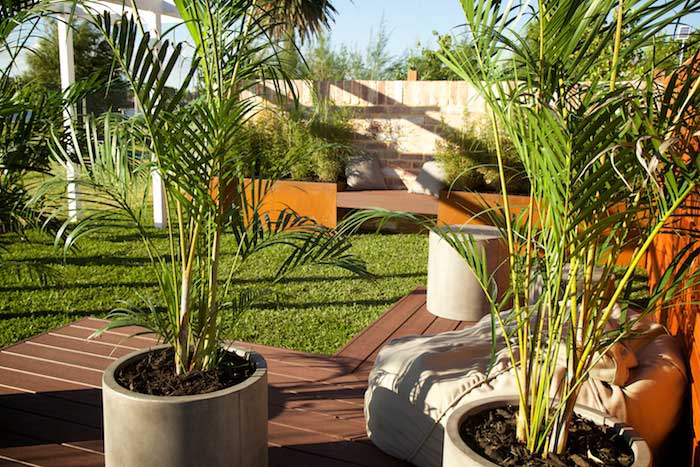
4. Add colour to your garden with flowers
Beautiful and vibrant flowers are always a sight to behold.
There are several resilient flowers that bloom throughout the year and can do so without much deadheading.
Petunias, Cosmos, and Begonias are some of the most beautiful flowers that remain appealing and lively year-round. Evergreen options are also a great way to keep a vibrant, healthy green colour in your garden year-round.
As always, do some research to get a better picture of which flowers suit your region and garden style the best.
5. Raised Garden Beds
Elevating the garden above the ground is one of the smartest decisions you can make if you want low maintenance garden beds.
Not only is it an excellent solution for poor soil conditions, but raised garden beds also are easier to work on since you can group plants that have similar needs.
If your garden soil is like heavy clay, you can take advantage of raised garden beds and create a great environment with new, clean, and fertile soil mixed with compost.
6. Add a handful of container plants.
You can spread these potted plants out throughout the garden. You can even place them by the edge of your stairs or in the shade by choosing plants that don’t need much sunlight to bloom.
You can spice your garden up with stylish, modern, and elegantly designed containers filled with vibrant plants.
Maybe you could match your house decor with these containers and make your garden feel like an extension of your home.
They’re easy to maintain, and you can keep shuffling things up to keep your garden fresh.
7. Self-watering pot plants.
Self-watering pots have become extremely popular these days because of their effectiveness and convenience.
Not only do they cut down on the chores you have to do, but they also keep the plants healthy and save water all year around.
Additionally, since the plants have access to water every second of the day, and the water reservoir bed is layered with mulch, there is less opportunity for weeds to grow.
What more could you ask for?
8. Use groundcover plants
Groundcover plants are an amazing way to transform areas that you don’t want to maintain as lawn or garden beds while still keeping your garden green and beautiful. Do you have an ugly patch of dirt that you need to cover up or gaps between pavers that you need to keep weed free? Ground cover plants are the perfect low-maintenance choice.
With flowering and evergreen options, they can suit all garden designs and styles.
Some great options are:
Star Jasmine
Native Violet
Grevillias
Bush Mint
Pratia
9. Add Gravel to your garden floor.
If you choose to cut out most of your lawn space because you don’t want to spend much time maintaining it, don’t just replace it with hard landscaping.
Instead, install gravel to your garden floor.
This allows the rainwater to drain away without causing any potential flooding. So not only is it low maintenance, it’s very practical.
And that’s it!
Most of the low maintenance garden design plans we’ve mentioned are not just to relieve effort from your end but also budget-friendly.
If you’d like us to do all the heavy-lifting and build the garden of your dreams that is truly maintenance-free, give us a call at 08 6263 4645
]]>When it comes to selecting the best plants for your pool area in Perth, there are a few key factors to consider. First and foremost, you’ll want to choose plants that are well-suited to the local climate and soil conditions. Perth is known for its hot, dry summers and mild winters, so you’ll want to choose plants that can tolerate these conditions. You’ll also want to consider the amount of sunlight that your pool area receives, as this will help you choose plants that are well-suited to these conditions.
How to Best Plants for Pool Areas
This guide will give you some ideas on how to choose the best plants for pool areas, letting you know some of the most chlorine-tolerant plants, along with what to look out for. This will help you save money and time and make sure you have the best pool plants
Select Litter Free Plants
Try to avoid plants that shed twigs and leaves all year round, so you don’t spend hours sweeping up your pool area before using it. Silky oaks, Illawarra flame trees and jacarandas shed leaves and flowers through the summer, making it a challenge to use your pool. Some plants that won’t drop too many leaves include flax, cordylines and palm trees.
A great litter-free plant for a pool area in Perth is the native grass species, Lomandra. This family of tough, drought-tolerant grasses are perfect for hot, dry areas and can withstand extreme heat and full sun exposure. Some of them, like longifolia do flower, so take that into consideration when planting – flowers in the pool can be annoying! Lomandra’s are a low-maintenance plant that require minimal watering and are resistant to pests and diseases while remaining evergreen. It’s a great choice for creating a natural, informal look around your pool.
Avoid Plants with Extensive Roots
Umbrella trees, bamboo, gum, deciduous trees and rubber trees might look good, but their extensive and sprawling roots can cause unseen damage below the ground with your underground pipes, paving and even the pool shell.
Watch Out For Pollen
Regular maintenance of your pool will make sure that pollen doesn’t cause too much damage to your filtration and cleaning equipment, although it’s impossible to keep all pollen out of the pool. Be sure to regularly clean or replace your baskets, cover your pool while you are away, and attach a fine material such as pantyhose or cheesecloth to your skimmer before cleaning pollen off your pool’s surface.
Pay Attention to New Plants
New plants will need extra care and attention before they are well established, including an initial deepwater planting and during the dryer months, at least twice a month. Plenty of mulch around smaller seedlings and plants will help to protect them from the sun, although you should keep mulch away from the trunk so as to prevent rot. If pool area plants are in direct sun for most of the day, a light shade cloth may be the solution.
Best Poolside Plants for Salt Water Swimming Pools
If you have a swimming pool containing salt water, make a point of planting some salt water tolerant plants in and around your pool area, to ensure they will thrive. Plants that have waxy, furry or silvery leaves are generally ideal if you want plants near your saltwater pool; some good examples of these include cycads, yucca plants, aloe, agaves and bromeliads.
Other plants that don’t mind being splashed by salty water every so often include echiums, pig face, coastal banksia, dianella, agave attenuates, and palms, many of which can be seen in coastal areas.
Best Poolside Plants for Chlorinated Swimming Pools
Some plants can withstand being splashed by chlorinated water better than others, although no plant is truly 100 per cent suited. Think of plants that have larger and leathery leaves, including golden cane palms, erigeron daisy, cordylines, murrayas and star jasmine.
Let Perth Landscaping Help Choose Your Poolside Plants
The most ideal approach to ensure your pool is both lovely and green and a safe and low-maintenance area, is to check your poolside plant selection with an expert landscape designer.
Let us know you’d like a chat with any of our local and qualified landscape designers to help with your pool plant selection and design.
We can advise and consult on your project, or help you start from scratch – just get in touch! Our team at Perth Landscaping would love to help with your pool plan!
]]>Client case study – Marcus – Backyard Re-design
At Perth Landscaping we love creating gardens you can be proud of – and that is exactly what we achieved for Marcus; a client with a very unimaginative and poorly-installed design who wanted a tailor-made, stunning outdoor area to integrate with his lifestyle and tastes.
Find out how we helped Marcus transform his ‘developer’s garden’ into an amazing space where he can be truly Garden Proud!
Marcus approached us last year with a simple problem, his courtyard wasn’t attractive. He described it as a ‘developers landscape’; basic, as-cheap-as-possible and just designed to be sold quickly. The courtyard had cheap, synthetic grass, a poor selection of plants and a leaking irrigation system.
You can see from these before photos that it was made to just ‘do the job’, not to be attractive and appealing in it’s own right.

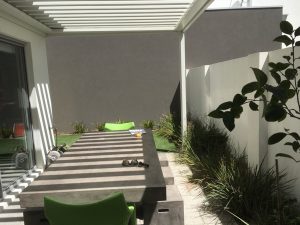
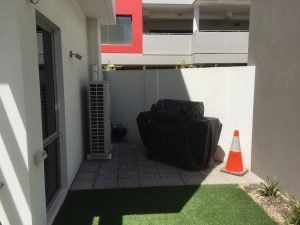
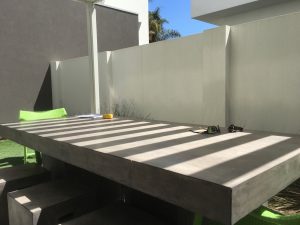
Marcus wanted a place to relax, where he can enjoy a glass of wine with friends and impress his guests with his taste and style.
After consulting with Marcus, we decided to create a low maintenance and easy-care landscape; creating the look and feel he was after by using native plants, corten steel made-to-measure garden beds and a lighting plan which provides ambience for those after-work drinks.
The process wasn’t easy as these new developments in the city have very narrow access. Our team had to navigate through the garage and laundry to access the back courtyard with all materials and tools. We removed a few cubic meters of sterile soil and waste and brought in a rich soil mix through the tiniest access. As our classic wheel barrow would only just fit through the doors we had to go and buy the smallest wheel barrow we could find.
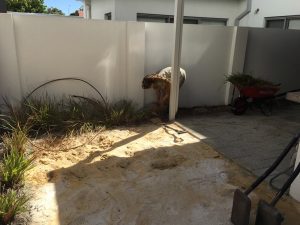
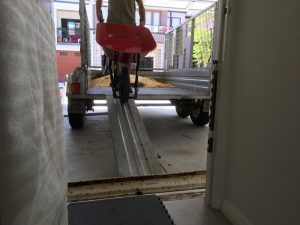

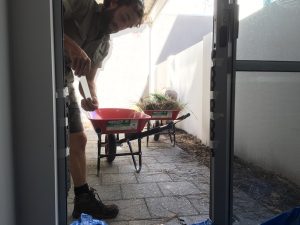
We created a low maintenance garden using mostly native and careful low-care plant selection. The use of a thick layer of mulch helps prevent weed growth and installation of a drip irrigation system combines to make an almost maintenance-free garden.
This small space has truly turned into a beautiful yet functional garden, and we have carefully used design elements to help the area feel warm and ambient but not cluttered. So even if you have a small space to work with, a thoughtfully planned landscape design will always help you get the most from your outdoors.
Garden Features:
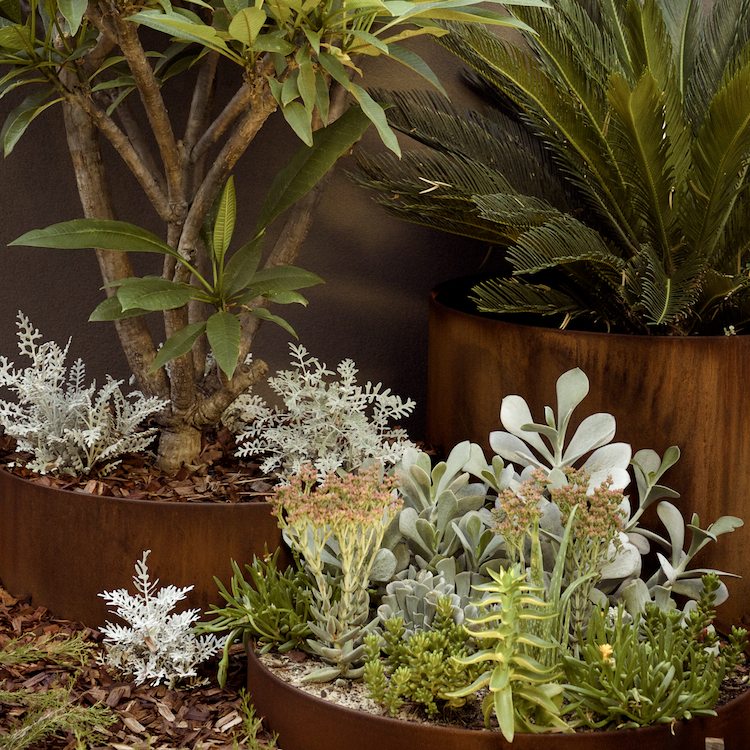
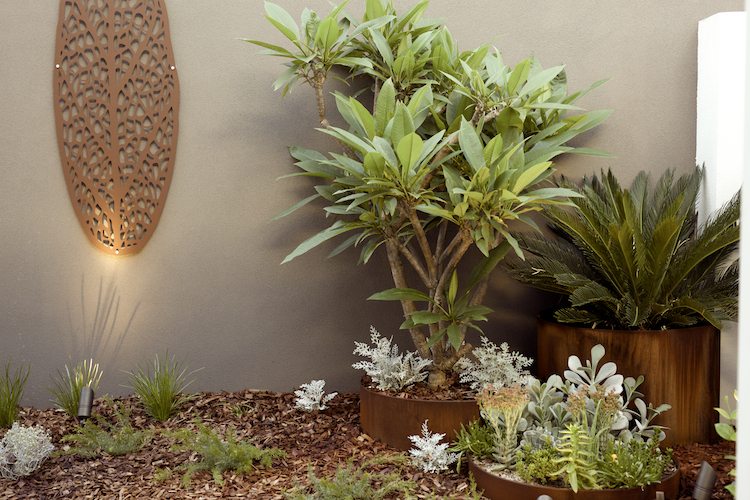
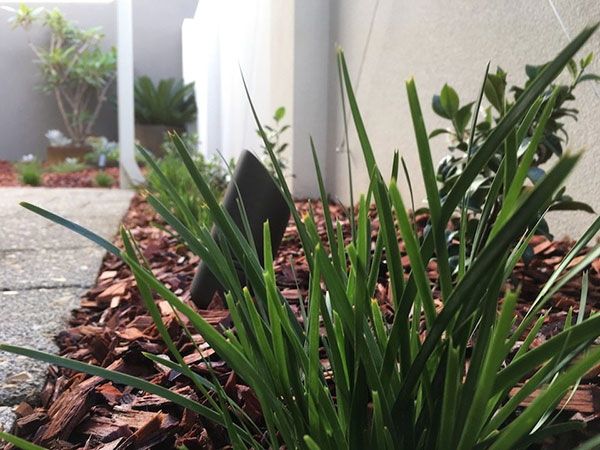
- Made-to-measure corten steel garden beds planted with a magnificent cycad, a frangipani tree and variety of succulents for depth and colour.
- A leaf sculpture wall feature, enhanced at night by the use of spot lighting.
- The northern wall has been mounted with stainless steel wires crossed over in diamond shapes, which will be used as a climbing frame by the Trachelospermum jasmnoide (Chinese Star Jasmine).
The final design is stylish, welcoming, complements his lifestyle needs, and is now the perfect place for Marcus to host guests on the weekend, or enjoy a peaceful evening with his family.

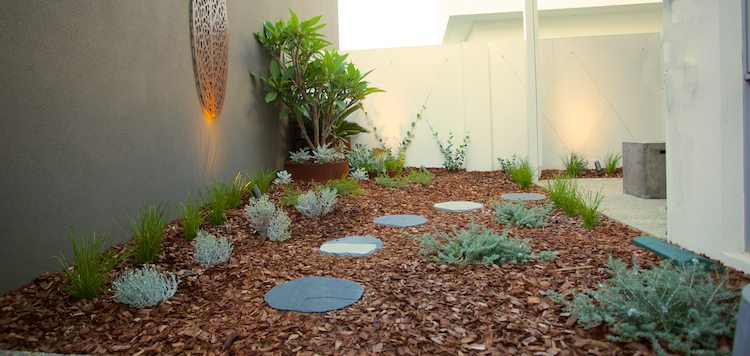
And topped off with a little Thank You gift from us – a stunning (and low-maintenance) succulent bowl.
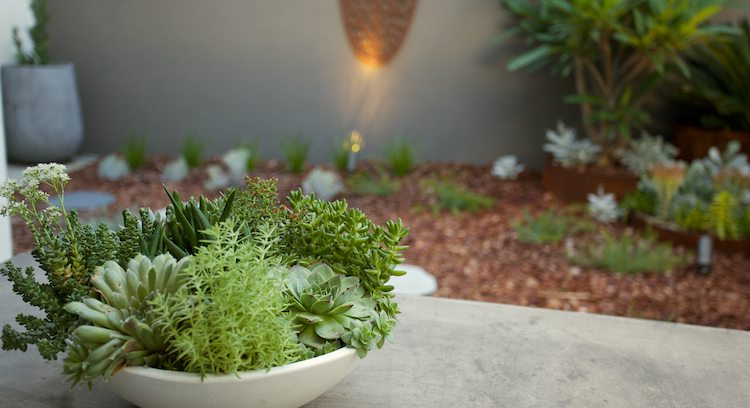
We are very pleased with how it turned out – but don’t just listen to us, here is what Marcus has to say…
If you too are wanting to transform your property and create a stunning landscape find out more about our landscape services or get in touch
]]>A pool is a must-have in Perth – it’s hard to get through those 40+ degree days without one! If you are looking to have a pool installed or wanting to create a gorgeous design for your existing pool that includes a lot of foliage, it’s important to have a good idea of what plants will look great without causing issues in the future. Most people would think to get a garden design before beginning to landscape their outdoors – but it’s just as important to have a good pool plant design before adding a bunch of plants to your pool area!
For example, some trees have very determined root growth, such as bamboo, umbrella trees and rubber trees, which can cause serious damage to your retaining walls or pool itself, while plants which attract bees and drop masses of leaves when it’s warm and you want to be swimming in clean and safe water, are probably not the best choices in close proximity to your pool.
IMPORTANT – Consider these before beginning to choose plants for your design…
- Do you have or plan to use limestone retaining walls in your pool design? This can make soils alkaline so make sure to choose plants which can cope with a high pH soil.
- Is your pool saltwater or chlorinated? If your pool is used as a bombing and playing area, not just causal dips to cool off, you will want to look for plants that are ok with being splashed (or drenched) with either salty or chlorinated water. A good tip; look for plants with silver, furry or waxy leaves – these are usually pretty happy to be near saltwater.
- Are you planting near a fence/wall? Fences heat up which then heats the soil so, combined with the reflection of the sun off the pool, your plants are in for a tough time. Choose hardy plants like our sturdy native Australian types that are used to hot and dry conditions, or make sure you feed and water the plants in your pool area a bit more than the others in your garden.
Where to start?
When designing your pool area, start with the larger shrubs/trees and choose where you want shade – maybe at one end of the pool so you always have the choice between sun and shade? Stay away from plants like the stunning Jacaranda which, sadly, have fine foliage, flowers, seed, pods, bark and twigs… the bane of any pool-owner’s existence. Remember – you will be cleaning that pool so choose plants that won’t make your life harder!
Note: although deciduous plants would seem to be on the ‘naughty list’ for a pool plant design, they tend to shed during winter in Perth. They do however hang on to their leaves in summer, so are worth considering if you love them and want to include them in your garden design.
Larger trees and shrubs that work well around pools are…
(these are also all limestone-tolerant)
- Hakea laurina or also known as Kodjet, Pincushion Hakea – can reach 5 meters in height.
- Hakea petiolaris or the sea-urchin Hakea – can grow 2-9m high.
- Leptospermum sericeum or Silver Teatree – can grow up to 1.5m, makes an excellent hedge.
- Banksia integrifolia or Coast Banksia – can grow 5m or higher depending on location
- Dodonea viscosa purpurea or Purple Hopbush. Can grow up to 5m tall
- Adenanthos sericeus or Woolly Bush – cand grow 3-5m tall.
- Acacia saligna or coojong, golden wreath wattle, orange wattle, blue-leafed wattle and Western Australian golden wattle – depending on the sub-species chosen they can grow from 2-8m tall.
- Acacia coriacea or river jam, wirewood, desert oak, wiry wattle or dogwood
- Grevillea longistyla – can grow up to 3 – 4m high and 2 – 3m wide.
Privacy – create a natural screen
Nobody wants to have their relaxing swim interrupted by the prying eyes of a neighbour or see a nice plumber shot of the guy working next door when quietly sipping a drink by the pool. This is where a good hedge, or a green-screen (as we like to call it), comes in to prevent these unfortunate events from intruding on your little oasis.
Decide how high you need the hedge to be based on the pool design, often 1 – 2m will do quite nicely, and what kind of look you are after, formal and well sculpted or more natural.
Shrubs for creating your ‘green-screen’ include…
- Ozothamnus diosmifolius or Radiance/Rice Flower – produces flowers almost year-round so avoid planting right next to the pool and increasing clean-up duty!
- Hibbertia cuneiformis or cut-leaf Hibbertia – WA native.
- Westringia brevifolia or ‘Lilac and Lace‘ / Coastal Rosemary – native and evergreen.
- Westringia ‘Wynyabbie Gem’ – native, grows dense and bushy.
- Eremophila or ‘Wild Berry‘ – native, also flowers year-round.
- Grevillea rosmarinifolia or Spider Flower – native, dense and bushy evergreen foliage.
- Banksia media or the Golden Stalk Banksia – native, grows in all soils – including sand.
Select plants to include in your design that are evergreen and flower in summer, making sure that your design looks good when you need it (swimming season!), as well as staying an asset to your landscape year-round.
The best way to make sure your pool is both a beautiful green haven and a safe and low-maintenance area, is to check with a professional landscape designer. They won’t just take looks into account, but will know what is best for your area based on soil, location, climate, and the myriad of other details that can’t be condensed into one blog post!
If you would like one of our landscape designers to help with your pool plant design, please get in touch – we can both design and install and would love to assist with your pool design!
]]>As such, your outdoor space will be an expression of your personality and your style.
Your backyard is an extension of your home. It is no different than your living room, kitchen, or bedroom in that you want to your landscape to have as much character and style as the rest of your house.
It should come as no surprise that there are many style options to choose from when it comes to creating custom landscaping.
For that extra little something to really accentuate your landscaping, have a look at some of our tips below…
1. Light Up Your Custom Landscaping with Fairy Lights
The night sky is a majestic, awe-inspiring blanket that covers the land when the sun rests for the day. Wouldn’t it be great to create an enchanting display right in your own home?
Lights create a sense of magic and add an intimate, romantic atmosphere to any landscape; twinkling fairy lights, strings of rustic lightbulbs, mason jars full of lights or tea candles …
Take your outdoors to the next level with the creative inclusion of lights within your design.
2. Entertain with Fire
No, not fire breathers or baton twirlers. Consider adding a fire pit or fireplace to your backyard. Both are excellent additions.
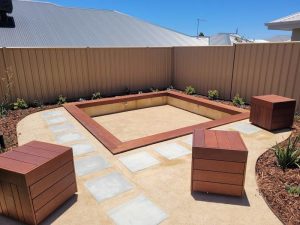
A fire pit can serve two functions:
- Operating as an open fire for you and your loved ones to gather around
- Cooking food
Cooking food might give the fire pit an edge if you like to entertain friends and family at home.
There are many choices to choose from, including a fire pit built into a table. Selecting the best one might be difficult but go with your personal tastes and the overall style and theme of your garden.
A fireplace is another great option, though you typically don’t get the added bonus of cooking with one.
If you’re just looking for something to sit around and soak up the warmth, this would be a great addition to unwind with.
3. Add a Gazebo or Pergola
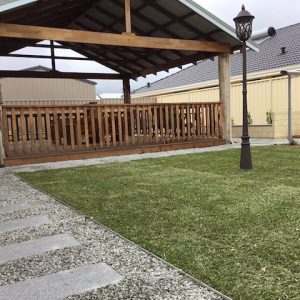
Maybe your ideal outdoor space involves hard landscaping. After all, what’s a fireplace without a cozy pergola or gazebo?
A pergola will add a characteristic flair to your custom landscaping design by creating rustic charm. You may even look to incorporate vines depending on the style you choose.
A gazebo can add either rustic or elegant charm. It serves a similar purpose as a pergola but typically comes with short walls and a floor.
Ultimately, it will come down to taste and what sort of style and feeling you’re looking to evoke with your landscape design.
4. Touch of charm
If you are looking for tranquil charm, the popular choice is to utilise features that look antiquated and simple, such as:
- A wheelbarrow (wooden or metallic) filled with flowers
- A trickling pond for that calming atmosphere the sound of water brings
- A wooden bench flowing with the natural shapes of the wood and blending into your landscape
- An abundance of plants – green or colorful
Using wooden materials will be a strong point in creating a rustic garden design, along with plants galore. Mix with fairy lights and you’ll be transported to an entirely new world.
Need help with your garden design?
These are merely ideas to help get the creativity flowing in making the most of your landscape design. If you need any help, contact one of our expert garden designers and we will be happy to help you create the garden of your dreams!
]]>Of course, you should choose one you will love and which suits the design, but you also need to understand the long-term effects and nature of the tree – they can have a large impact on many areas of your design and garden.
Choosing Trees for Landscaping
Consult the often-asked questions about landscape trees questions below and our list of possible hazards before making your selection…
1. What is the size of your garden area, and how much space are you willing to have the tree occupy?
A large tree offers shade, can be used as a focal point for your design, keeps the garden & house cool in summer, provides entertainment for the kids and creates healthy air for you to enjoy in your garden. But consider how large it can grow before planting; if it grows too much and you aren’t prepared, removing it can be an expensive and problematic procedure, and a huge loss to the environment.

2. Function or Feature?
Are you looking to use trees for a functional purpose such as; screening from neighbours or street, shade and protection from the elements, to attract birdlife into your garden, for fruit, etc. Or maybe as a feature in your garden design, like a focal point, maybe for its colour or shape, for its fragrance, or to create a break or private area in your space.
3. Do you use your garden year-round?
All nature follows a cycle, and not taking that into account can create havoc with your design. For example, deciduous trees provide fabulous shade in summer, but lose all their leaves and are bare in winter. This can be great for letting in and making the most of the winter light, but if you used them as a screen within your design, suddenly you are exposed for months to prying eyes and lose your privacy. Not to mention dealing with a lot of leaves clean-up come autumn! Evergreens on the other hand shed lightly throughout the year and stay green during winter – but you can lose a lot of light because of that reason.
However, both have many great features which can be used to your advantage if carefully chosen and planned from the beginning.
Possible Hazards From Poor Selection and Placement of Landscape Trees
1. Problems from falling leaves/flowers/fruits
If the wrong tree is put in proximity to gutters, entertaining areas, or features like pools or waterfalls, then in autumn you could be facing fun problems like blocked drains, pools to clean, and guests wading through soggy, rotting leaves. Many trees look stunning but aren’t great in garden designs for people who want a clean, low-maintenance yard. Avoid trees like Jacarandas, Eucalyptus or trees with pine needles and cones.
Trees like Marri and Jarrah attract noisy cockatoos who will also shred and eat the tree quite happily, causing mess, damage and commotion. Often it is a matter of placement, so you can include a stunning Jacaranda tree in your design – just think carefully before you plant it!
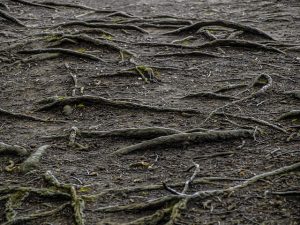
2. Damage from root systems
Some trees have strong and wide-spread root systems that can affect pools, paving, roads, drains, and underground systems. We’ve all seen that friend’s backyard where their prized tree has broken and cracked the paving, damaged their reticulation, or lifted up a wall – and just with its roots! Trees from the Ficus and Tipuana families, and many of the large Eucalyptus can cause problems with their root systems.
If you plant on your verge or are in the middle of developing, and more than one-third of the root system gets damaged by road-works or construction, it might not be able to recover and then you are left dealing with a potential hazard.
3. Proximity to neighbours
Overhanging trees can cause damage to fences and boundaries or, worst-case scenario, cause disputes between you and your neighbour that develop into a legal and financial problem. This can be avoided by regular pruning, careful planning and tree selection.
Is it Necessary to Prune Landscape Trees?
It’s a common mistake to assume that trees ‘need’ pruning. Apart from commercial fruit trees, they really don’t. Unless it is a safety issue of potential falling branches, impact on property or due to damage, you can leave your tree to grow as large as it wants – and it will be happier and healthier that way!
How Can a Landscape Designer Help you Choose Trees for Landscaping?
A good designer should have extensive plant knowledge and, if you live in Perth, know all about our native trees and what works best in the Western Australian climate.
A designer will be able to assess your garden and know which landscape trees will give you the result you are looking for, while making sure your design is as safe and carefully planned as possible to prevent problems in the long-run.
They can also look at your existing trees and if and how you can incorporate them into your design. An experienced and creative landscape designer should be able to work a tree into your design – removing a healthy and fully-grown tree should be a last resort!
Remember; landscape tree selection is for the long-term, you are planning for the future. It is too common nowadays to simply remove perfectly good trees to make way for planting new ones that might seem to be the better option for a design. In Perth there are very few trees over 100 years-old – imagine if yours was the next to last that long!
Don’t let something as small as a poorly-chosen tree get in the way of your dream garden design – give us a call and our expert landscapers will help you out.
]]>